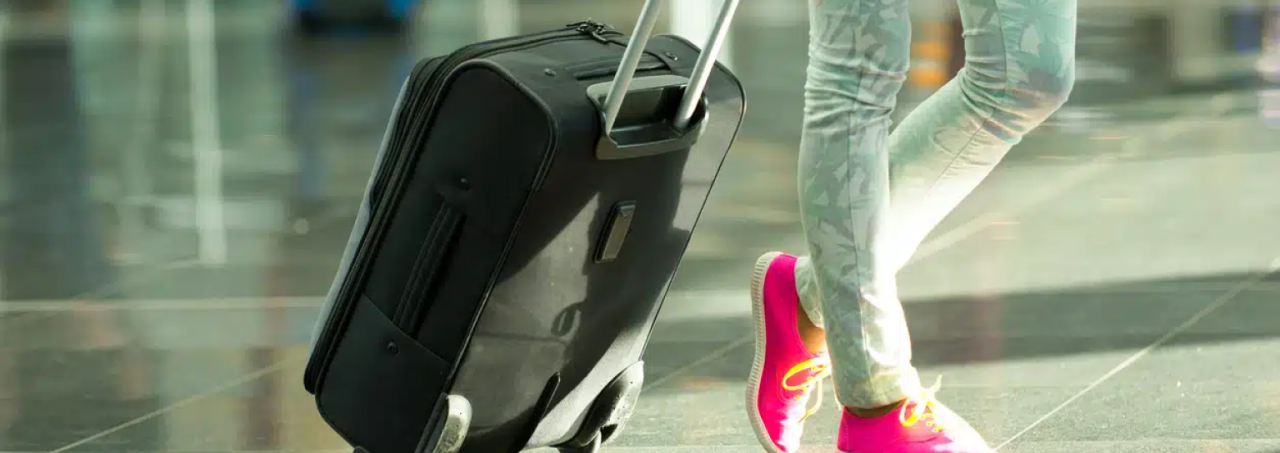
What does it tell us about humanity that we put a man on the moon (1969) 18 years before we put wheels on luggage (1987)?
This very question has been lighting up the information superhighway’s geekier rabbit holes (where this author regularly resides) and the reasons are slightly more nuanced than “we just didn’t get round to thinking about it”.
It turns out that a key reason such a simple solution arrived nearly two decades after such a large step for mankind, is because of significant resistance between idea and launch. The original inspiration for wheeled luggage arrived to American luggage executive Bernard Sadow in 1970, as he was returning home from a family holiday. Hauling heavy luggage through an airport, he noticed an airport worker effortlessly rolling a heavy machine on a wheeled skid.
What possible reason could there be to resist no longer having to carry heavy luggage around by hand? Turns out there were quite a few, with cultural norms of the day and the frail male ego both high on the list.
In design terminology he was understanding the problem through lived experience, and conceiving the solution by amalgamating two products which had existed for centuries, namely luggage (invented in the 12th century, primarily to carry weaponry) and the wheel (invented in the 4th millennium BC, with no requirement to be reinvented). That little piece of insight – noticing the airport worker having a significantly better time than he was – was all it took to connect the problem to a solution.
Sadow designed some prototypes, registered a patent and got to work selling his “rolling luggage” as he referred to it on his patent application.
What possible reason could there be to resist no longer having to carry heavy luggage around by hand?
Turns out there were quite a few, with cultural norms of the day and the frail male ego both high on the list. In a 2010 interview, Sadow observed “people do not accept change well” as he recalls his sales call with department stores in New York and elsewhere. His most common objection during those conversations was the department stores’ view that men would not accept suitcases with wheels. “It was a very macho thing” he said.
In the early 1970s, it was considered chivalrous for men to carry luggage for their wives, and crucially far fewer women travelled alone than do today. So, there were strong cultural draws to retain the status quo. That said, Sadow was nothing if not persistent and he was rewarded with a breakthrough when Macy’s placed an order and began to feature “the Luggage that Glides.”
Lest we descend (ascend?) further into self–righteousness, to this day cultural norms and engrained habits hamper innovation. In 2002 Transport for London (TfL) carried out a time–in–motion study on their busiest London Tube stations during morning and evening rush hours. While there were variations depending on the size of the station, the study demonstrated that a station could process 28% additional passengers per minute if commuters stood on both sides of the escalator versus the status quo of regular commuters standing on the right with commuters in a rush then walking up or down on the left.
TfL immediately started to pilot programmes in key stations asking commuters to stand on both sides of the escalator, an initiative which was successfully introduced in Hong Kong’s underground a decade earlier. The difficulty was that after decades of TfL announcements “stand on the right”, married with social convention – gentle tutting behind you if you stood on the wrong side – TfL simply couldn’t persuade travellers to stand on both sides and the pilot was abandoned. With London transport demand expected to rise 60% by 2050, they might well need to have another go at some stage in the future.
Sales of rolling luggage remained slow until another frequent traveller, 747 pilot Robert Plath invented the Rollaboard in 1987, which featured two wheels rather than four, rolled upright and included the now–ubiquitous telescoping upright handle. The product didn’t go mainstream straightaway as he initially sold it to fellow flight crew members, the majority of whom were female. It was only when the general public started to see cabin crew members effortlessly strolling through airports with their luggage behind them that the product moved from the airline industry to mass market.
Notwithstanding the cultural and habitual challenges of successfully innovating, there is something intriguing about the “hidden in plain sight” nature of the rolling luggage as an elegant solution to a common problem. Might it also reveal some of our inbuilt biases around perceived simplicity and perceived complexity? Lebanese–American mathematical statistician Nassim Nicholas Taleb argues that the rolling suitcase acts as a parable highlighting our bias to value the difficult, grandiose and complex more highly than the simple.
This parable leaves us with a very interesting thought experiment. When an author two–generations hence is writing about innovation in the 2020s, which of our glaring blind–spots will be exposed by the spotlight of hindsight?


